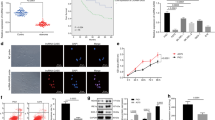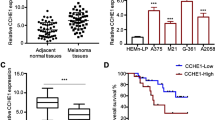Abstract
Purpose
lncRNA H19 has been considered as an oncogenic lncRNA in many human tumours. In the present study, we identify the role and molecular mechanism of lncRNA H19 in melanoma.
Method
QRT-PCR was used to detect the expression of lncRNA H19 and E2F3 was detected in melanoma tissues. Cell counting kit-8 (CCK8), representative metabolites analysis was used to explore the biological function of lncRNA H19, miR-106a-5p and E2F3 in melanoma cells. Bioinformatics, luciferase reporter assays, MS2-RIP and RNA pull-down assay was used to demonstrate the molecular mechanism of lncRNA H19 in melanoma. We further test the function of lncRNA H19 in vivo though Xenograft tumour assay.
Results
We found that lncRNA H19 was increased in melanoma tissue, and lncRNA H19 was correlated with poor prognosis of melanoma patients. miR-106a-5p acts as a tumour suppressor in melanoma by targeting E2F3. E2F3 affects the melanoma cell glucose metabolism and growth. We also demonstrated that lncRNA H19 may function as the sponge of miR-106a-5p to up-regulate E2F3 expression, and consequently promote the glucose metabolism and growth of melanoma.
Conclusions
This result elucidates a new mechanism for lncRNA H19 in melanoma development and provides a survival indicator and potential therapeutic target for melanoma patients.







Similar content being viewed by others
References
Arancio W, Pizzolanti G, Genovese SI, Baiamonte C, Giordano C (2014) Competing endogenous RNA and interactome bioinformatic analyses on human telomerase. Rejuvenation Res 17:161–167
Berteaux N, Lottin S, Monte D, Pinte S, Quatannens B, Coll J, Hondermarck H, Curgy JJ, Dugimont T, Adriaenssens E (2005) H19 mRNA-like noncoding RNA promotes breast cancer cell proliferation through positive control by E2F1. J Biol Chem 280:29625–29636
Gupta RA, Shah N, Wang KC, Kim J, Horlings HM, Wong DJ, Tsai MC, Hung T, Argani P, Rinn JL, Wang Y, Brzoska P, Kong B, Li R, West RB, van de Vijver MJ, Sukumar S, Chang HY (2010) Long non-coding RNA HOTAIR reprograms chromatin state to promote cancer metastasis. Nature 464:1071–1076
Hanahan D, Weinberg RA (2011) Hallmarks of cancer: the next generation. Cell 144:646–674
Hauptman N, Glavac D (2013) Long non-coding RNA in cancer. Int J Mol Sci 14:4655–4669
He QY, Wang GC, Zhang H, Tong DK, Ding C, Liu K, Ji F, Zhu X, Yang S (2016) miR-106a-5p Suppresses the Proliferation, Migration, and Invasion of Osteosarcoma Cells by Targeting HMGA2. DNA Cell Biol 35:506–520
Hombach S, Kretz M (2013) The non-coding skin: exploring the roles of long non-coding RNAs in epidermal homeostasis and disease. Bioessays 35:1093–1100
Jiang YJ, Bikle DD (2014) LncRNA profiling reveals new mechanism for VDR protection against skin cancer formation. J Steroid Biochem Mol Biol 144(Pt A):87–90
Johnsson P, Ackley A, Vidarsdottir L, Lui WO, Corcoran M, Grander D, Morris KV (2013) A pseudogene long-noncoding-RNA network regulates PTEN transcription and translation in human cells. Nat Struct Mol Biol 20:440–446
Kroemer G, Pouyssegur J (2008) Tumor cell metabolism: cancer’s Achilles’ heel. Cancer Cell 13:472–482
Little EG, Eide MJ (2012) Update on the current state of melanoma incidence. Dermatol Clin 30:355–361
Liu C, Chen Z, Fang J, Xu A, Zhang W, Wang Z (2016) H19-derived miR-675 contributes to bladder cancer cell proliferation by regulating p53 activation. Tumour Biol 37:263–270
Liu H, Dai C, Wu Q, Liu H, Li F (2017) Expression profiling of long noncoding RNA identifies lnc-MMP3–1 as a prognostic biomarker in external auditory canal squamous cell carcinoma. Cancer Med 6:2541–2551
Luan W, Wang Y, Chen X, Shi Y, Wang J, Zhang J, Qian J, Li R, Tao T, Wei W, Hu Q, Liu N, You Y (2015) PKM2 promotes glucose metabolism and cell growth in gliomas through a mechanism involving a let-7a/c-Myc/hnRNPA1 feedback loop. Oncotarget 6:13006–13018
Luan W, Li L, Shi Y, Bu X, Xia Y, Wang J, Djangmah HS, Liu X, You Y, Xu B (2016) Long non-coding RNA MALAT1 acts as a competing endogenous RNA to promote malignant melanoma growth and metastasis by sponging miR-22. Oncotarget 7:63901–63912
Lv J, Yu YQ, Li SQ, Luo L, Wang Q (2014) Aflatoxin B1 promotes cell growth and invasion in hepatocellular carcinoma HepG2 cells through H19 and E2F1. Asian Pac J Cancer Prev 15:2565–2570
Millet A, Martin AR, Ronco C, Rocchi S, Benhida R (2017) Metastatic melanoma: insights into the evolution of the treatments and future challenges. Med Res Rev 37(1):98–148
Okamoto K, Morison IM, Taniguchi T, Reeve AE (1997) Epigenetic changes at the insulin-like growth factor II/H19 locus in developing kidney is an early event in Wilms tumorigenesis. Proc Natl Acad Sci USA 94:5367–5371
Rachmilewitz J, Elkin M, Rosensaft J, Gelman-Kohan Z, Ariel I, Lustig O, Schneider T, Goshen R, Biran H, de Groot N et al (1995) H19 expression and tumorigenicity of choriocarcinoma derived cell lines. Oncogene 11:863–870
Schmidt K, Joyce CE, Buquicchio F, Brown A, Ritz J, Distel RJ, Yoon CH, Novina CD (2016) The lncRNA SLNCR1 Mediates Melanoma Invasion through a Conserved SRA1-like Region. Cell Rep 15:2025–2037
Scott DA, Richardson AD, Filipp FV, Knutzen CA, Chiang GG, Ronai ZA, Osterman AL, Smith JW (2011) Comparative metabolic flux profiling of melanoma cell lines: beyond the Warburg effect. J Biol Chem 286:42626–42634
Scrable HJ, Sapienza C, Cavenee WK (1990) Genetic and epigenetic losses of heterozygosity in cancer predisposition and progression. Adv Cancer Res 54:25–62
Shi Y, Wang Y, Luan W, Wang P, Tao T, Zhang J, Qian J, Liu N, You Y (2014) Long non-coding RNA H19 promotes glioma cell invasion by deriving miR-675. PLoS One 9:e86295
Soares MR, Huber J, Rios AF, Ramos ES (2010) Investigation of IGF2/ApaI and H19/RsaI polymorphisms in patients with cutaneous melanoma. Growth Horm IGF Res 20:295–297
Subramanian M, Li XL, Hara T, Lal A (2015) A biochemical approach to identify direct microRNA targets. Methods Mol Biol 1206:29–37
Tay Y, Rinn J, Pandolfi PP (2014) The multilayered complexity of ceRNA crosstalk and competition. Nature 505:344–352
Tech K, Deshmukh M, Gershon TR (2015) Adaptations of energy metabolism during cerebellar neurogenesis are co-opted in medulloblastoma. Cancer Lett 356:268–272
Vander Heiden MG, Cantley LC, Thompson CB (2009) Understanding the Warburg effect: the metabolic requirements of cell proliferation. Science 324:1029–1033
Wang KC, Chang HY (2011) Molecular mechanisms of long noncoding RNAs. Mol Cell 43:904–914
Wang Y, Zhang Y, Yang T, Zhao W, Wang N, Li P, Zeng X, Zhang W (2017) Long non-coding RNA MALAT1 for promoting metastasis and proliferation by acting as a ceRNA of miR-144–3p in osteosarcoma cells. Oncotarget 8:59417–59434
Zhang H, Chen Z, Wang X, Huang Z, He Z, Chen Y (2013) Long non-coding RNA: a new player in cancer. J Hematol Oncol 6:37
Zhi F, Zhou G, Shao N, Xia X, Shi Y, Wang Q, Zhang Y, Wang R, Xue L, Wang S, Wu S, Peng Y, Yang Y (2013) miR-106a-5p inhibits the proliferation and migration of astrocytoma cells and promotes apoptosis by targeting FASTK. PLoS One 8:e72390
Funding
This study was funded by The Health and Family Planning Science and Technology Key project Foundation of Zhenjiang city (SHW2017004), The Social Development and Technology Support Foundation of Zhenjiang city (SH2011057), and The Clinical Medical Science and Technology Development Fund of Jiangsu University (JLY20160002).
Author information
Authors and Affiliations
Corresponding authors
Ethics declarations
Conflict of interest
The authors declare that they have no competing interests.
Ethical approval
All applicable international, national, and/or institutional guidelines for the care and use of animals were followed. All procedures performed in studies involving human participants were in accordance with the ethical standards of the institutional and/or national research committee and with the 1964 Helsinki declaration and its later amendments or comparable ethical standards.
Informed consent
Informed consent was obtained from all individual participants included in the study.
Electronic supplementary material
Below is the link to the electronic supplementary material.
432_2018_2582_MOESM2_ESM.tif
Supplementary Figure 1 (A) lncRNA H19 was mainly distributed in cytoplasm analyzed by FISH. lncRNA H19 was labeled by Cy3 (red). Nucleus was stained by DAPI (blue). The tissue sections were observed in 400X magnification. The slides of cells were observed in 600X magnification. (B) The excision tumour in nude mice of A375 xenografts. (TIF 689 KB)
Rights and permissions
About this article
Cite this article
Luan, W., Zhou, Z., Ni, X. et al. Long non-coding RNA H19 promotes glucose metabolism and cell growth in malignant melanoma via miR-106a-5p/E2F3 axis. J Cancer Res Clin Oncol 144, 531–542 (2018). https://doi.org/10.1007/s00432-018-2582-z
Received:
Accepted:
Published:
Issue Date:
DOI: https://doi.org/10.1007/s00432-018-2582-z




